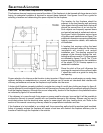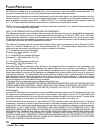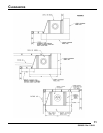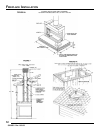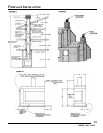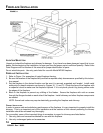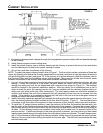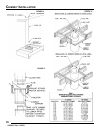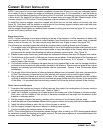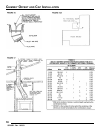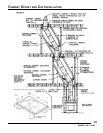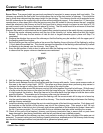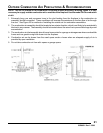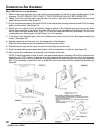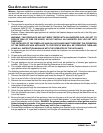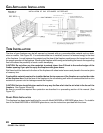
17
CHIMNEY OFFSET INSTALLATION
ELBOW INSTALLATION
NOTE: If triple wall elbow is to be placed directly to the top of the fireplace, it will be necessary to bend a tab
over located on each of the four inlet air collar brackets. bend these tabs over only when using a triplewall
elbow to start a chimney run. The tabs may be easily bent with your fingers or pliers. See figure 16A.
The following are important points that should be observed when installing elbows on the fireplace:
1. The support straps of all elbows not installed directly on top of the fireplace should be nailed securely to the
surrounding structure. This allows the support strap to carry the weight of the chimney above the elbow
and prevents this weight from breaking the elbow or chimney sections apart. See Figure 16.
2. Elbows should not be used in any combination that inclines the chimney more than 30 degrees from vertical.
3. The limitations on the quantity of elbows per chimney are as follows: If the total height of the fireplace and
chimney is — 16' 0" or more — two elbows may be used in the chimney. 21' 0" or more — four elbows
may be used in the chimney.
4. The inclined portions of chimneys that pass through living spaces likely to be used for storage should be
enclosed to avoid contact with and possible damage to the chimney. The minimum air space of two inches
between the chimney and enclosing materials must be maintained. Figures 17 and 18 illustrates elbow
installations.
5. The length of the inclined portion of chimney between elbows must not exceed 6 feet when unsupported or
20 feet if the chimney is supported at six-foot intervals with support such as metal support straps.
6. When enclosing the elbows and inclined portions of the chimney, enclosing materials must be installed
vertically to maintain the required two-inch minimum air space clearance to the chimney at the extremities
of the offset. It is recommended that enclosing material not follow the inclined portions of the chimney.
O
FFSET INSTALLATION SEQUENCE
1. Determine the location and amount of offset required, then select the combinations of chimney sections
and elbows required from the offset chart. Refer to Table 2.
2. Install the first elbow by placing the crimped end into the mating part of the fireplace or chimney section.
Push down until the outside or inlet air duct of the elbow overlaps and the snaps lock the elbow into the
fireplace or chimney section.
3. Nail the support straps to the framing member with a minimum of two 8-penny nails per strap.
4. Install the sections of pipe between elbows until the proper number of chimney sections have been installed.
5. Install the second elbow to return the run of the chimney to vertical.
6. Nail the support straps of the second elbow to a building frame member.
7. Continue installing the vertical portion of the chimney.
NOTE: If the inclined portion of the chimney passes through a floor or ceiling, an SF30 firestop spacer should
be installed to provide the firestop and support required. Be sure proper spacing in maintained between the
chimney and combustibles. See Figure 19.
53D9051. Rev 1 03/03
NOTE: If you intend to have a total fireplace installation of more than 30 feet, you must use a chimney support
at or below 30 feet to support the weight of additional chimney pipe. If it is impossible to nail the chimney
support to the load bearing framing of the builing at the 30 foot level, the chimney support may be installed at
a lower level if the height of the chimney above the support does not exceed 30 feet. Effective height of the
chimney support is 16-3/4 inches. Chimney supports must be installed at 30 foot intervals.
To install the chimney support, place the crimped end of the flue into the last section of chimney pipe (see
figure 15). Push down until the outside or inlet air duct of the chimney support overlpas and snaps and snap
locks the chimney support into the chimney section.
Nail the support straps tightly to a building frame member or ceiling joist as shown by figure 15. You must use
at least two 8 penny nails per strap.



